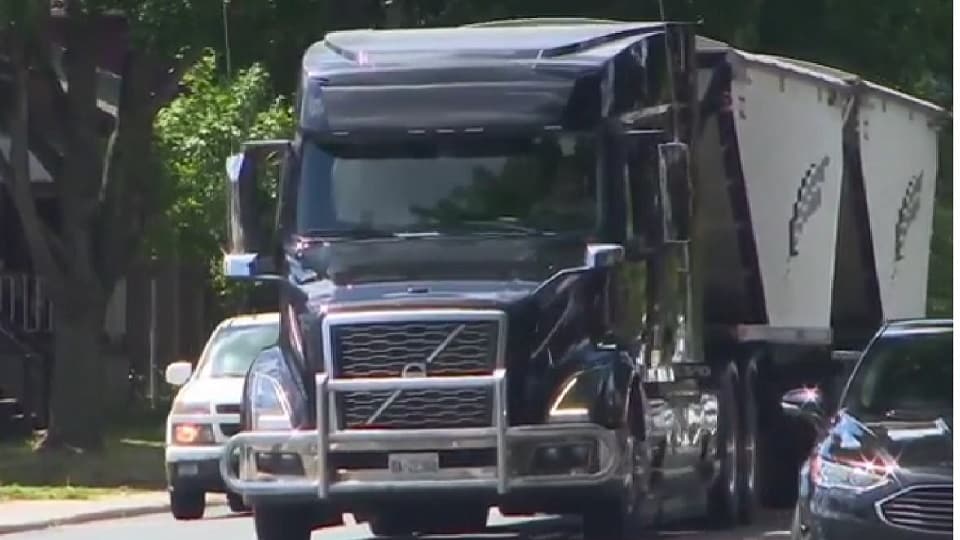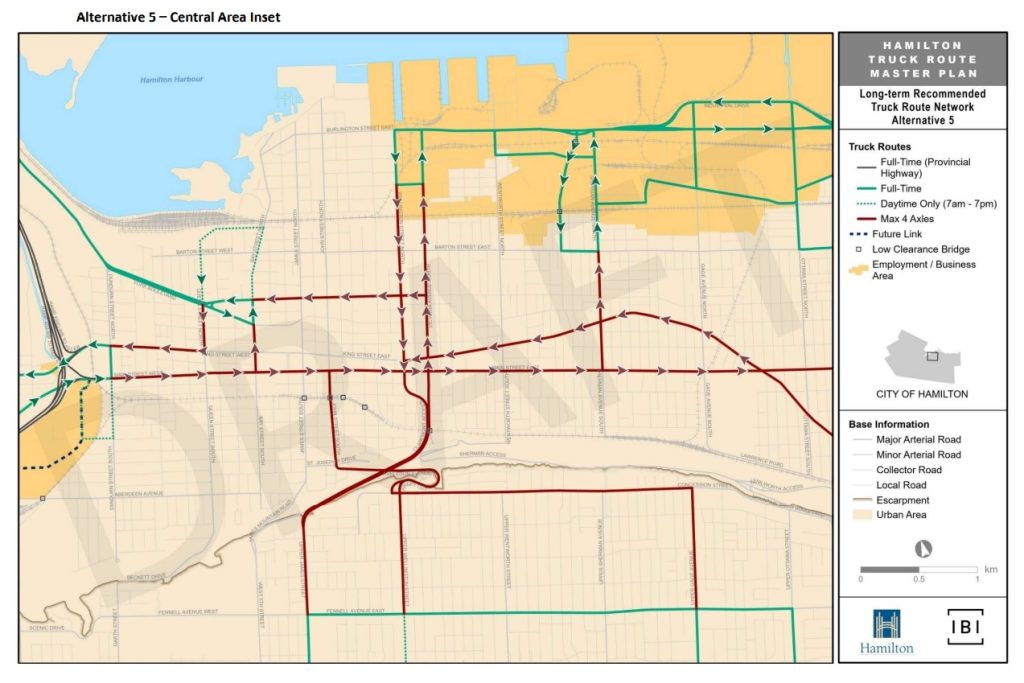Hamilton banning big trucks on downtown streets
Published March 28, 2022 at 11:46 pm

The days of downtown Hamilton residents hearing a heavy truck rumble past will soon end, pending city council approval.
On Monday, capping off three years of consulting with affected parties, city council’s truck route subcommittee approved a plan that will bar big trucks — those with five or more axles — from using Barton and Cannon streets as a ‘cut through.’ Local residents have advocated for years about the health effects from noise and diesel emissions from trucks using Barton and Cannon to get to York Boulevard and Hwy. 403.
The larger trucks will have to go easterly along Burlington Street, where they can use the Red Hill Valley Parkway and Lincoln Alexander Expressway to access Highway 403 if they are headed west. Burlington Street also connects to the Queen Elizabeth Way highway. King, Main and most of Victoria and Wellington Streets will also only four-axled vehicles.
The approach will require refining and further work with city staff. But the option that council chose — Alternative 5, out of six prepared by staff — was approved 6-0.
“This has probably been one of the most impossible balancing acts to come forward with a future master plan,” Ward 6 Coun. Tom Jackson said near the end of a five-hour meeting. “I believe, though, this is a step in the right direction — to think about how we move.”
Ward 2 Coun. Jason Farr, along with Jackson and Couns. Brenda Johnson (Ward 11), Sam Merulla (4), Nrinder Nann (3) and Maureen Wilson (2), voted in favour. The choice would need the full council’s ratification.

Trucking industry representatives warned of increased food costs for the public and the possibility of more, albeit smaller, trucks being on the streets in order to complete deliveries. Lynda Lukasik, the executive director of Environment Hamilton, contended during her delegation that the trade-off from the status quo affects the health outcomes of lower-city residents.
“Private sector players are free riders inflicting impacts in order to cut their own costs,” Lukasik said. “The case of the heavy industrial trucks is a classic case of imposing negative extranalities. My sense is that if a truly comprehensive cost-benefit analysis was done, including assessing those non-monetary costs, the current truck route reality imposes the larger cost burden on community, than the cost that will be incurred on the private sector players if they have to travel some extra kilometres (because of re-routing) in a more restrictive system.
“We have talked about those externalities — they include noise, and vibrations. We know those impacts are disrupting sleep for some residents. In some cases residents are worried about structural damage to their homes. Air polllution, we’ve measured with our basic particulate monitoring devices. From heavy diesel truck emissions, truck brake and tire dust, is especially problematic for the very young, and very old and those with respiratory challenges.”
Delegating for the agribusiness industry, Hugh Loomans of Sylvite Agri Services said that the option that the committee chose is one the industry can mostly abide.
“It allows us one route to get back to the (westbound) 403,” Loomans noted. “Eighty per cent of agricultural goods coming into Hamilton are from Western Ontario, from the London area. That’s the important issue.”
‘Positive guidance’
The report that was presented to councillors by Omar Shams of the City of Hamilton transportation planning department, suggested the axle restriction would make compliance and enforcement more straightforward. Hamilton Police Service officers who are on enforcement duty could more easily identify a truck with excess axles instead of one that is overweight.
“The four-axle restriction provides accessibility and positive guidance for local delivery trucks while minimizing the unavoidable impact of heavy trucks on sensitive receptors, low income and vulnerable residential communities,” the report reads. “This restriction would preclude non-local delivery trucks from traversing the downtown and residential communities while encouraging the use of smaller vehicles for local delivery purposes. However, it may require more trucks to deliver the same amount of goods which has cost implications for both shippers and receivers.”
Lak Shoan, director of policy of the Ontario Trucking Association, also emphasized that extra travel time could result in higher consumer prices for food. (Several major Canadian grocery chains are already enjoying solid profits. For instance, Loblaws cleared $5.5 billion in 2021.)
Shoan, however, did not have a firm answer when Jackson asked how road restriction information is relayed to drivers. Jackson framed his question by saying it’s a common experience for HPS officers conducting enforcement to hear that a driver did not know that the truck they were operating was forbidden from the road.
“Typically, we release the information to our members,” Shoan said. “It’s typically left up to them to follow instructions. Sometimes a vehicle is equipped with a tablet or an on-board device… so these instructions can be loaded.
“Truck drivers are fairly transient (moving between employers),” Shoan added. “It’s very possible that there could be a number of drivers who are not unfamiliar with those routes, or are doing a route for the first time, or something along those lines.”
(Graphic via City of Hamilton.)
insauga's Editorial Standards and Policies advertising





